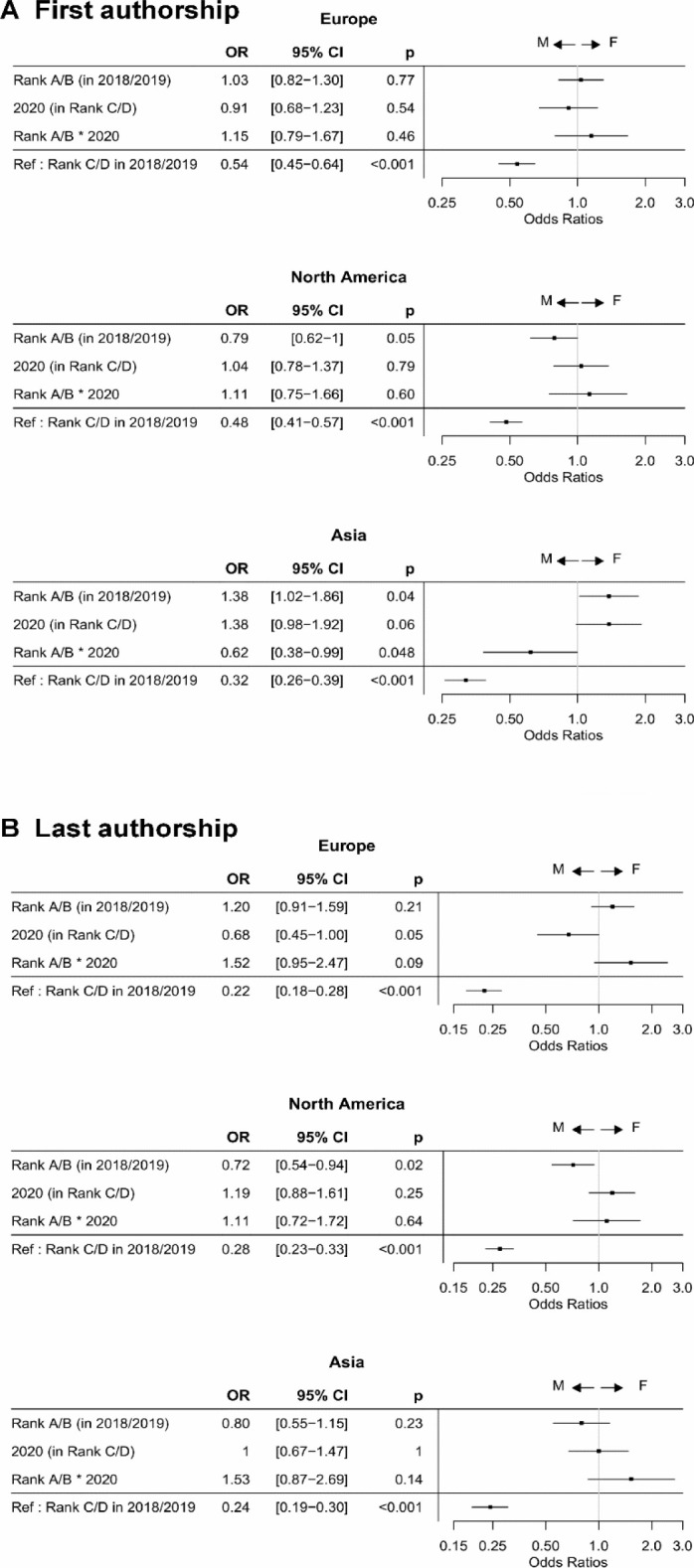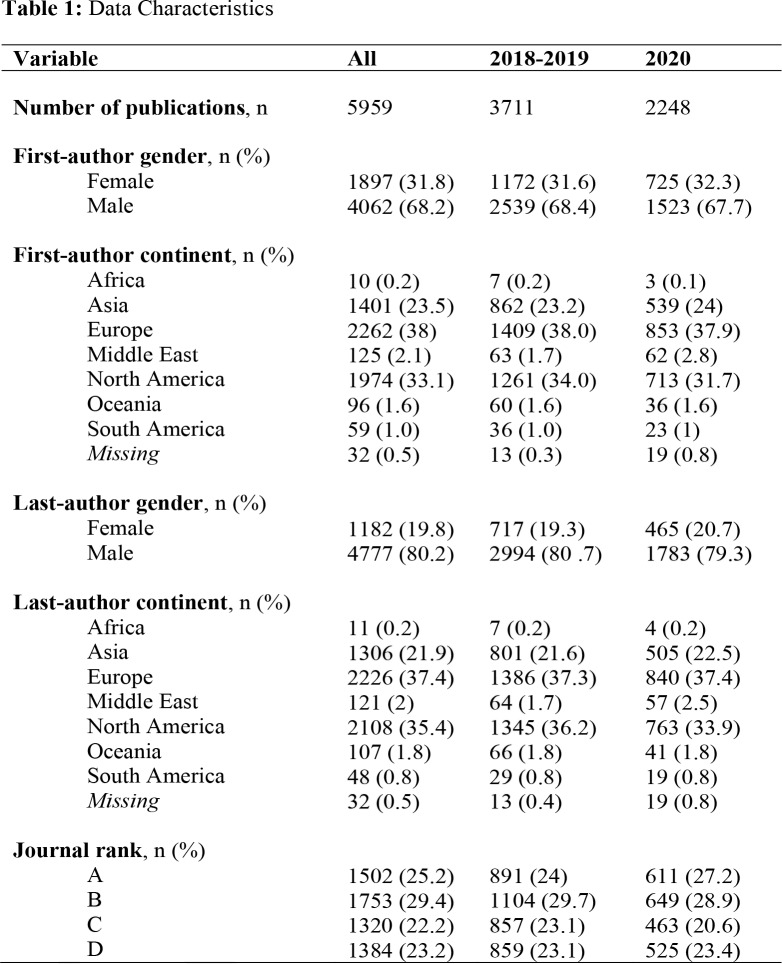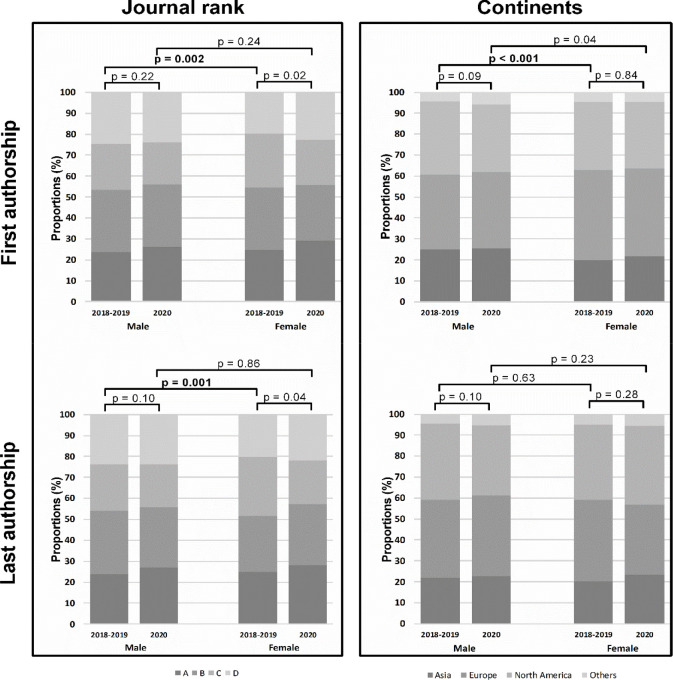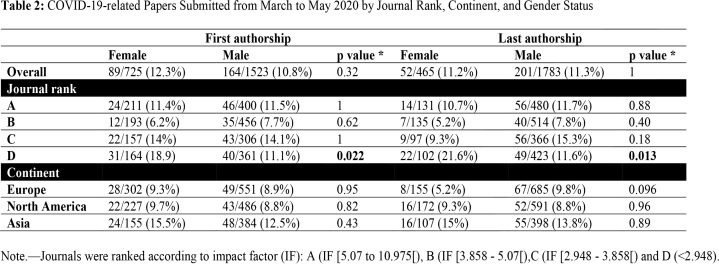Abstract
Background
Early reports show the unequal effect the COVID-19 pandemic might have on men versus women engaged in medical research.
Purpose
To investigate whether the COVID-19 pandemic has had an impact on scientific publishing by female physicians in medical imaging.
Materials and Methods
We conducted a descriptive bibliometric analysis of first and last-author gender of papers submitted to the top 50 medical imaging journals from March to May 2020 (n=2480) compared to the same period of the year in 2018 (n=2238) and 2019 (n=2355). Manuscript title, date of submission, first and last name of first and last authors, journal impact factor and author country of provenance were recorded. The Gender-API software was used to determine author gender. Statistical analysis comprised Chi square tests and multivariable logistic regression.
Results
Percentages of female first- and last-authorship were 1172/3711 (31.6%) and 717/3711 (19.3%) in 2018- 2019 versus 725/2248 (32.3%) and 465/2248 (20.7%) in 2020 (p=0.61 and p=0.21 respectively), and of COVID-19-related papers 89/253 (35.2%) and 52/253 (20.6%) respectively. No associations were found between first and last author gender, year of publication and continent of provenance. First- and last-authorship of high-ranking papers was not in favor of North American females whatever the year: OR 0.79 (p=0.05) and OR 0.72 (p=0.02). Higher rates of female last-authorship of high-ranking papers were observed in Europe (p=0.003): OR 1.20 (p=0.21) in 2018-2019 multiplied by interaction term OR 1.52 (p=0.09) in 2020, and of female first-authorship of low-ranking papers in Asia: OR=1.38 [0.98-1.92] (p=0.06) in 2020. Female first- and last-authorship of COVID-19-related papers was overrepresented for lowest-rank papers (p=0.02 and p=0.01).
Conclusion
One in three first authors and one in five last authors were female in 2018-2019 and 2020. While the first 2020 lockdown did not diminish the quantity of female publications, the impact upon the quality was variable.
See also the editorial by Robbins and Khosa.
Keywords: Physicians, Women, Authorship, COVID-19, Radiology, Nuclear Medicine
Summary
The COVID-19 pandemic has not aggravated the gender imbalance in first and last authorship of medical imaging publications.
Key Results
■ In medical imaging, one in three first (31.6%) and one in five last (19.3%) authors were female. This gender gap was similar for papers submitted during the first 2020 lockdown (32.3%, p=0.61 and 20.7%, p=0.21).
■ In 2020, the quality of female publications altered favorably for European last (p=0.003), and an unfavorable tendency was observed for Asian first authors (p=0.06). Female publication quality did not alter in North America (p=0.60 for first and p=0.64 for last authors).
■ Female first and last authors of COVID-19-related papers were overrepresented in the lowestrank journals (p=0.02 and p=0.01).
Introduction
In many countries today, females make up half of medical students, and the number of female students choosing to pursue their career in medical imaging (radiology and nuclear medicine) is rising (1,2). However, the higher up the career ladder, the lower the proportion of females, a phenomenon known as ‘the leaky pipeline’ (3). Compared to their male colleagues, females are underrepresented as authors, and leadership positions in medical imaging, either within institutions, or within scientific organizations, committees, boards, or journals are still dominated by males (4–6). Examples of challenges females face in general are male-dominated cultures and networks, lack of female mentors, and explicit and implicit gender biases in recruitment, research allocation, outcome of peer-review and citations (7–10). Working mothers face the well described maternal wall bias, where maternal stereotyping and discrimination undermine their professional performance (11).
Early reports on the effects of the COVID-19 pandemic on scientific research, all fields concerned, mention the deleterious effect the pandemic might have on the career of parents working in science, and in particular on the scientific output of female researchers (12–17). This is due to an unbalanced division of work, as females still perform the majority of household chores and care work, even in developed countries perceived as gender-egalitarian (18,19). As schools and daycare facilities closed in many countries during the first COVID-19 related lockdown, the pandemic might thus eventually affect female career advancement, as the number and quality of publications in peer-reviewed journals one has authored are essential.
The purpose of this study was to investigate whether the COVID-19 pandemic might have an impact on scientific publishing by female physicians in medical imaging. We performed a descriptive bibliometric analysis of female first- and last-authorship over the 3-month period corresponding to the first lockdown period in most countries due to the COVID-19 pandemic.
Materials and methods:
This study was exempt from local institutional review board approval.
On August 19th 2020 we performed a PubMed search over the period 2018 to 2020 to retrieve all articles published by the top 50 journals, ranked by impact factor, in the category Radiology, Nuclear Medicine & Medical Imaging of the Journal of Citation Reports 2018. Ranks 1 to 65 were included, excluding 15 radiotherapy and medical physics journals. The 2020 data were updated on November 26th 2020. The bibliographic references of articles were imported into the bibliographical data management software Reference Manager. In addition to the usual bibliographic fields, an import filter was created to include the following data concerning PubMed bibliographic notices: date of submission, first name and last name of all authors, and affiliation addresses. From this database we extracted the references of manuscripts submitted in the period from March to May for each year, corresponding to the first lockdown period in 2020 in most countries. This dataset was exported to Excel, and the following variables were recorded for each entry: manuscript title, date of submission, first and last name of the first and last authors, journal impact factor (IF), and country of provenance of first and last authors. The Gender-API software was then used to determine the gender of the first and last authors. In the event of missing data, entries were excluded. Countries were classified according to continent (Africa, Asia, Europe, Middle East, North America, South America, and Oceania (Oceania includes Australasia, Melanesia, Micronesia and Polynesia)). COVID-19-related articles were retrieved in Excel by selecting article titles mentioning the terms COVID, nCoV, SARS, Corona.
The main objective was to analyze the percentages of female first- and last-authorship (the most prestigious author positions) of papers submitted to peer-reviewed medical imaging journals during the COVID-19 pandemic as compared to the same period of the year in 2018 and 2019. Secondary objectives were to evaluate the percentages of female first- and last-authorship of COVID-19-related articles, and the proportions of female authorship according to journal rank and according to continent. Paper impact factors were categorized according to quartiles. Chi square tests, with Bonferroni corrections when necessary, were used to analyze links between gender and the other qualitative variables. A multivariable logistic regression with Analysis of Variance was also performed in subgroups of continents to investigate the predominance of male or female last- and first-authorship according to journal rank and year. Graphic and statistical analyses were performed on XLSTAT Software (XLSTAT 2007: Data Analysis and Statistical Solutions for Microsoft Excel, Addinsoft (2017)) and R Software (version 4.0.2). For all statistical tests, we retained a two-tailed p value of less than 0.05 as statistically significant.
Results
Data characteristics
A total of 7073 references of accepted papers with submission date from March till May were imported for the years 2018 (n=2238), 2019 (n=2355) and 2020 (n=2480). Gender of the first and/or last author could be determined for 1814/2238 (81.1%) of references in 2018, 1897/2355 (80.6%) in 2019 and 2248/2480 (90.6%) in 2020. Country of provenance could be determined for 1813/1814 (99.9%) of references in 2018, 1885/1897 (99.4%) in 2019 and 2229/2248 (99.2%) in 2020. Papers were classified according to journal rank: A (IF [5.07 to 10.975[), B (IF [3.858 - 5.07[), C (IF [2.948 - 3.858[) and D (<2.948). Data characteristics are presented in Table 1.
Table 1:
Data Characteristics
First-authorship
Univariable analysis
Female first-authorship proportions were not different between 2018-2019 and 2020 (1172/3711 (31.6%) and 725/2248 (32.3%) respectively, p=0.61). Female first-authorship of COVID-19-related papers was found to be 89/253 (35.2%). In 2020, 89/725 (12.3%) of papers submitted by a female first author concerned COVID-19 versus 164/1523 (10.8%) for male first authors (p=0.32).
Concerning journal rank, as compared to 2018-2019, females published proportionally more papers in journals ranked A and D in 2020 and fewer in journals ranked B and C (p=0.02, Figure1). Concerning COVID-19-related papers, gender was associated with journal rank, with more female first-authorship in rank D journals (18.9% versus 11.1%, p= 0.02) (Table 2).
Figure 1:
Univariable analysis of publications according to gender, journal rank, and continent for first and last authorship. P values correspond to Chi square tests with Bonferroni corrections and bold values are statistically significant.
Table 2:
COVID-19-related Papers Submitted from March to May 2020 by Journal Rank, Continent, and Gender Status
Concerning the continent of origin of first authors, 5637/5959 (94.6%) of all publications came from Europe (2262/5959 (38%)), North America (1974/5959 (33.1%)) and Asia (1401/5959 (23.5%)) (Table 1). African, Oceanian, and South American data were insufficient to be independently included in the statistical analyses, therefore they were grouped. Both in 2018-2019 and 2020, there were associations between first-author gender and the continent of origin (p< 0.001 and p = 0.04 respectively, Figure 1).
Concerning COVID-19-related papers, continent of origin and first-author gender were not associated (Table 2).
Multivariable analysis
African, Oceanian and South American data were insufficient to be included in the multivariable analysis. Therefore, multivariable analysis was performed on European, North American and Asian data only.
In Europe, gender imbalances did not alter in 2020. First-authorship in journals rank A or B was not in favor of females in North America (OR=0.79 [0.62-1]), whatever the year according to analysis of variance (p=0.04). First-authorship in Asia tended to be in favor of females for journals rank C or D in 2020 (OR=1.38 [0.98-1.92]) p=0.06.
Last-authorship
Univariable analysis
Female last-authorship proportions were not different between 2018-2019 and 2020 (717/3711 (19.3%) and 465/2248 (20.7%) respectively, p=0.21). Female last-authorship of COVID-19-related papers was found to be 52/253 (20.6%) in 2020. In 2020, 52/465 (11.2%) of papers submitted by a female last author concerned COVID-19 versus 201/1783 (11.3%) for male last authors (p=0.96).
Concerning journal rank, the proportion of publications in rank A journals with a female last author was higher in 2020 as compared to 2018-2019 (p=0.04, Figure 1). In 2018-2019, there was an association between gender and journal rank (p=0.001), with proportionally more female authors in journals rank C and more male authors in rank B. Concerning COVID-related papers, there were more female lastauthorship publications in rank D journals as compared to male last-authorship in 2020 (21.6% versus 11.6%, p=0.01, Table 2).
Concerning the continent of origin of last authors, most of the publications were again from Europe (2226/5959(37.4%)), North America (2108/5959(35.4%)) and Asia (1306/5959(21.9%)) (Table 1). Both in 2018-2019 and 2020 last author’s continent of origin and gender were not associated (p=0.63 and p=0.23 respectively, Figure 1). Regarding COVID-related papers, continent of origin and gender were not associated with regard to last-authorship (Table 2).
Multivariable analysis
Last-authorship gender in Europe was associated with journal rank (p=0.004), with a tendency in favor of female authors in journals rank A or B in 2018-2019 (OR=1.20 [0.91-1.59]), but clearly favorable in 2020 (OR ranks A/B in 2018-2019=1.20 multiplied by interaction term OR ranks A/B in 2020=1.52 resulting in OR=1.82, p=0.003) as compared with C and D ranks (Figure 2B). Last-authorship in rank A or B journals was not in favor of females in North America (OR=0.72 [0.54-0.94]), whatever the year according to analysis of variance (p=0.007). In Asia, no associations were observed between journal rank, year and last-author gender.
Figure 2:

Multivariable analysis presented as odds ratio plots of author gender according to continent, journal rank and year of publication. (A) First author gender, and (B) Last author gender. Reference values correspond to Rank C or D in 2018-2019. Error bars indicate 95% confidence intervals.
Discussion
Our study showed a gender imbalance in first- and last-authorship for papers submitted to the top 50 medical imaging journals in the months March to May for the years 2018 to 2020. In 2018-2019, 31.6% of first authors and 19.3% of last authors were female. The first lockdown period due to the COVID-19 pandemic did not alter these findings, as in 2020 32.2% of first and 20.7% of last authors were female (p=0.61 and p=0.21 respectively). In 2020, high-rank female publications accentuated favorably for European last (p=0.003), and low-rank female publications accentuated for Asian first authors (p=0.06). Female publication quality did not alter in North America (p=0.64 for last and p=0.60 for first authors). Female first and last authors of COVID-19-related papers were overrepresented in the lowest-rank journals (p=0.02 and p=0.01).
The percentages of female first- and last-authorship found here correspond to findings from other groups (20–22). However, our study was not limited to the few most prestigious A-rank journals. The full panel of the top 50 medical imaging journals was included, as this can be considered the ‘playing field’ when attempting to publish a paper.
Do the percentages of female first- and last-authorship we found correspond to the gender disparity in the medical imaging workforce worldwide? Studies addressing this issue show that females make up 33.5% of radiologists worldwide, with large disparities between countries (2,23,24). In Europe, less gender disparity has been reported for the younger generations as reflected in the membership of the European Society of Radiology (6). However, despite more females entering a career in medical imaging, they lag behind their male peers in career advancement (3,4,6,25,26).
Although gender bias in peer review has been reported (27,28), our study did not reveal a disproportionate underrepresentation of female authors in high-rank journals and overrepresentation in lower-rank journals, apart from an underrepresentation of North American female first and last authors in high-rank journals. The first 2020 lockdown seemed to have a positive effect on publication quality by female European last authors, and on the contrary, a negative effect on publication quality by female Asian first-authors. An overrepresentation of female last authors of COVID-19-related papers was found in the lowest-rank journals. Explanations for these effects on quality rather than quantity of female publications are probably multifactorial, and the degree to which they are related to the lockdown and the unbalanced division of household tasks remains to be explored. However, gender bias in grant allocations and nominations for senior and leadership positions might partly explain the low percentage of 20% female last-authorship, as this position usually corresponds to the supervisor or principal investigator.
We acknowledge our study has limitations. Firstly, the 2020 data is incomplete. Peer review and editorial decision-making has not been completed for some of the papers submitted in the March to May 2020 period. Secondly, the non-COVID-19-related scientific work submitted during the lockdown was initiated largely before the pandemic, with first- and last-authorship assigned b efore. Thirdly, as we write, the COVID-19 pandemic is still ongoing. Our study is an early report with short-term data from spring 2020. Fourthly, we used the online Gender-API platform to determine first- and last-author gender. Lastly, we chose to limit our study to papers submitted in the period from March to May. Therefore, national or regional disparities might have been overlooked.
Male dominance in first- and last-authorship of imaging publications was evident in the top 50 medical imaging journals over the years 2018 to 2020. The first lockdown due to the COVID-19 pandemic in 2020 did not substantially alter this imbalance. Leaders and physicians should be aware of explicit and implicit gender biases that affect scientific publications (29).
Acknowledgments
Acknowledgements
The authors wish to thank Ann Mary Boyce for her assistance in drafting the manuscript.
Footnotes
Abbreviations:
- OR
- Odds Ratio
- M
- does not favor female authorship
- F
- favors female authorship
References
- 1.Als C, Andiel AG. Comments on profession and gender statistics of the EANM membership database 2007. Eur J Nucl Med Mol Imaging. 2008;35(5):1026–1029. doi: 10.1007/s00259-008-0737-x. [DOI] [PubMed] [Google Scholar]
- 2.Bluth EI, Bansal S, Macura KJ, Fielding J, Truong H. Gender and the Radiology Workforce: Results of the 2014 ACR Workforce Survey. J Am Coll Radiol. 2015;12(2):155–157. doi: 10.1016/j.jacr.2014.07.040. [DOI] [PubMed] [Google Scholar]
- 3.Weigel KS, Kubik-Huch RA, Gebhard C. Women in radiology: why is the pipeline still leaking and how can we plug it? Acta Radiol. 2020;61(6):743–748. doi: 10.1177/0284185119881723. [DOI] [PubMed] [Google Scholar]
- 4.Moghimi S, Khurshid K, Jalal S, et al. Gender Differences in Leadership Positions Among Academic Nuclear Medicine Specialists in Canada and the United States. Am J Roentgenol. 2019;212(1):146–150. doi: 10.2214/AJR.18.20062. [DOI] [PubMed] [Google Scholar]
- 5.Filardo G, da Graca B, Sass DM, Pollock BD, Smith EB, Martinez MA-M. Trends and comparison of female first authorship in high impact medical journals: observational study (1994-2014). BMJ. 2016;i847. doi: 10.1136/bmj.i847. [DOI] [PMC free article] [PubMed] [Google Scholar]
- 6.Kubik-Huch RA, Vilgrain V, Krestin GP, et al. Women in radiology: gender diversity is not a metric—it is a tool for excellence. Eur Radiol. 2020;30(3):1644–1652. doi: 10.1007/s00330-019-06493-1. [DOI] [PMC free article] [PubMed] [Google Scholar]
- 7.Koch AJ, D’Mello SD, Sackett PR. A meta-analysis of gender stereotypes and bias in experimental simulations of employment decision making. J Appl Psychol. 2015;100(1):128–161. doi: 10.1037/a0036734. [DOI] [PubMed] [Google Scholar]
- 8.Larivière V, Ni C, Gingras Y, Cronin B, Sugimoto CR. Bibliometrics: Global gender disparities in science. Nature. 2013;504(7479):211–213. doi: 10.1038/504211a. [DOI] [PubMed] [Google Scholar]
- 9.Huang J, Gates AJ, Sinatra R, Barabási A-L. Historical comparison of gender inequality in scientific careers across countries and disciplines. Proc Natl Acad Sci. 2020;117(9):4609–4616. doi: 10.1073/pnas.1914221117. [DOI] [PMC free article] [PubMed] [Google Scholar]
- 10.Huang M, Naser-Tavakolian K, Clifton M, et al. Gender Differences in Article Citations by Authors from American Institutions in Major Radiology Journals. Cureus. 2019;11(8):e5313. doi: 10.7759/cureus.5313. [DOI] [PMC free article] [PubMed] [Google Scholar]
- 11.Verniers C, Vala J. Justifying gender discrimination in the workplace: The mediating role of motherhood myths. Amaral LAN, editor. PLOS ONE. 2018;13(1):e0190657. doi: 10.1371/journal.pone.0190657. [DOI] [PMC free article] [PubMed] [Google Scholar]
- 12.Andersen JP, Nielsen MW, Simone NL, Lewiss RE, Jagsi R. Meta-Research: COVID-19 medical papers have fewer women first authors than expected. eLife. 2020;9:e58807. doi: 10.7554/eLife.58807. [DOI] [PMC free article] [PubMed] [Google Scholar]
- 13.Gabster BP, van Daalen K, Dhatt R, Barry M. Challenges for the female academic during the COVID-19 pandemic. The Lancet. 2020;395(10242):1968–1970. doi: 10.1016/S0140-6736(20)31412-4. [DOI] [PMC free article] [PubMed] [Google Scholar]
- 14.Minello A. The pandemic and the female academic. Nature. 2020;d41586-020-01135–01139. doi: 10.1038/d41586-020-01135-9. [DOI] [PubMed] [Google Scholar]
- 15.Staniscuaski F, Kmetzsch L, Zandonà E, et al. Gender, race and parenthood impact academic productivity during the COVID-19 pandemic: from survey to action. Scientific Communication and Education; 2020 Jul. doi: 10.1101/2020.07.04.187583. [DOI] [PMC free article] [PubMed] [Google Scholar]
- 16.Viglione G. Are women publishing less during the pandemic? Here’s what the data say. Nature. 2020;581(7809):365–366. doi: 10.1038/d41586-020-01294-9. [DOI] [PubMed] [Google Scholar]
- 17.Myers KR, Tham WY, Yin Y, et al. Unequal effects of the COVID-19 pandemic on scientists. Nat Hum Behav. England; 2020;4(9):880–883. doi: 10.1038/s41562-020-0921-y. [DOI] [PubMed] [Google Scholar]
- 18.Cerrato J, Cifre E. Gender Inequality in Household Chores and Work-Family Conflict. Front Psychol. 2018;9:1330. doi: 10.3389/fpsyg.2018.01330. [DOI] [PMC free article] [PubMed] [Google Scholar]
- 19.Jolly S, Griffith KA, DeCastro R, Stewart A, Ubel P, Jagsi R. Gender Differences in Time Spent on Parenting and Domestic Responsibilities by High-Achieving Young Physician Researchers. Ann Intern Med. 2014;160(5):344–353. doi: 10.7326/M13-0974. [DOI] [PMC free article] [PubMed] [Google Scholar]
- 20.Yun EJ, Yoon DY, Kim B, et al. Closing the Gender Gap: Increased Female Authorship in AJR and Radiology. Am J Roentgenol. 2015;205(2):237–241. doi: 10.2214/AJR.14.14225. [DOI] [PubMed] [Google Scholar]
- 21.Piper CL, Scheel JR, Lee CI, Forman HP. Gender Trends in Radiology Authorship: A 35-Year Analysis. Am J Roentgenol. 2016;206(1):3–7. doi: 10.2214/AJR.15.15116. [DOI] [PubMed] [Google Scholar]
- 22.Pyatigorskaya N, Di Marco L. Women authorship in radiology research in France: An analysis of the last three decades. Diagn Interv Imaging. 2017;98(11):769–773. doi: 10.1016/j.diii.2017.07.001. [DOI] [PubMed] [Google Scholar]
- 23.Cater SW, Yoon SC, Lowell DA, et al. Bridging the Gap. Acad Radiol. 2018;25(8):1052–1061. doi: 10.1016/j.acra.2017.12.021. [DOI] [PubMed] [Google Scholar]
- 24.Chapman CH, Hwang W-T, Both S, Thomas CR, Deville C. Current Status of Diversity by Race, Hispanic Ethnicity, and Sex in Diagnostic Radiology. Radiology. 2014;270(1):232–240. doi: 10.1148/radiol.13130101. [DOI] [PubMed] [Google Scholar]
- 25.Hamidizadeh R, Jalal S, Pindiprolu B, et al. Influences for Gender Disparity in the Radiology Societies in North America. Am J Roentgenol. 2018;211(4):831–838. doi: 10.2214/AJR.18.19741. [DOI] [PubMed] [Google Scholar]
- 26.Battaglia F, Shah S, Jalal S, et al. Gender disparity in academic emergency radiology. Emerg Radiol. 2019;26(1):21–28. doi: 10.1007/s10140-018-1642-7. [DOI] [PubMed] [Google Scholar]
- 27.Fox CW, Paine CET. Gender differences in peer review outcomes and manuscript impact at six journals of ecology and evolution. Ecol Evol. 2019;9(6):3599–3619. doi: 10.1002/ece3.4993. [DOI] [PMC free article] [PubMed] [Google Scholar]
- 28.Helmer M, Schottdorf M, Neef A, Battaglia D. Gender bias in scholarly peer review. eLife. 2017;6:e21718. doi: 10.7554/eLife.21718. [DOI] [PMC free article] [PubMed] [Google Scholar]
- 29.Coe IR, Wiley R, Bekker L-G. Organisational best practices towards gender equality in science and medicine. Lancet Lond Engl. 2019;393(10171):587–593. doi: 10.1016/S0140-6736(18)33188-X. [DOI] [PubMed] [Google Scholar]





